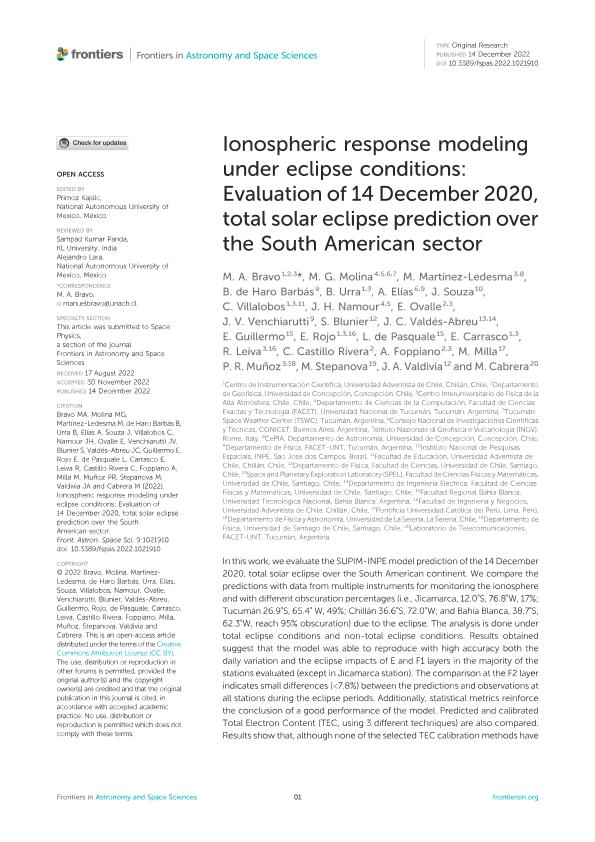Artículo
Ionospheric response modeling under eclipse conditions: Evaluation of 14 December 2020, total solar eclipse prediction over the South American sector
Bravo, M. A.; Molina, Maria Graciela ; Martínez Ledesma, Miguel; de Haro Barbás, Blas Federico; Urra, B.; Elias, Ana Georgina
; Martínez Ledesma, Miguel; de Haro Barbás, Blas Federico; Urra, B.; Elias, Ana Georgina ; Souza, J.; Villalobos, C.; Namour, Jorge Habib; Ovalle, E.; Venchiarutti, José Valentín
; Souza, J.; Villalobos, C.; Namour, Jorge Habib; Ovalle, E.; Venchiarutti, José Valentín ; Blunier, S.; Valdés Abreu, J.C.; Guillermo, Eduardo Daniel; Rojo, E.; de Pasquale, Lorenzo; Carrasco, E.; Leiva, R.; Castillo Rivera, C.; Foppiano, A.; Milla, M.; Muñoz, P. R.; Stepanova, M.; Valdivia, J. A.; Cabrera, Miguel Angel
; Blunier, S.; Valdés Abreu, J.C.; Guillermo, Eduardo Daniel; Rojo, E.; de Pasquale, Lorenzo; Carrasco, E.; Leiva, R.; Castillo Rivera, C.; Foppiano, A.; Milla, M.; Muñoz, P. R.; Stepanova, M.; Valdivia, J. A.; Cabrera, Miguel Angel
 ; Martínez Ledesma, Miguel; de Haro Barbás, Blas Federico; Urra, B.; Elias, Ana Georgina
; Martínez Ledesma, Miguel; de Haro Barbás, Blas Federico; Urra, B.; Elias, Ana Georgina ; Souza, J.; Villalobos, C.; Namour, Jorge Habib; Ovalle, E.; Venchiarutti, José Valentín
; Souza, J.; Villalobos, C.; Namour, Jorge Habib; Ovalle, E.; Venchiarutti, José Valentín ; Blunier, S.; Valdés Abreu, J.C.; Guillermo, Eduardo Daniel; Rojo, E.; de Pasquale, Lorenzo; Carrasco, E.; Leiva, R.; Castillo Rivera, C.; Foppiano, A.; Milla, M.; Muñoz, P. R.; Stepanova, M.; Valdivia, J. A.; Cabrera, Miguel Angel
; Blunier, S.; Valdés Abreu, J.C.; Guillermo, Eduardo Daniel; Rojo, E.; de Pasquale, Lorenzo; Carrasco, E.; Leiva, R.; Castillo Rivera, C.; Foppiano, A.; Milla, M.; Muñoz, P. R.; Stepanova, M.; Valdivia, J. A.; Cabrera, Miguel Angel
Fecha de publicación:
12/2022
Editorial:
Frontiers Media
Revista:
Frontiers in Astronomy and Space Sciences
ISSN:
2296-987X
Idioma:
Inglés
Tipo de recurso:
Artículo publicado
Clasificación temática:
Resumen
In this work, we evaluate the SUPIM-INPE model prediction of the 14 December 2020, total solar eclipse over the South American continent. We compare the predictions with data from multiple instruments for monitoring the ionosphere and with different obscuration percentages (i.e., Jicamarca, 12.0°S, 76.8°W, 17%; Tucumán 26.9°S, 65.4° W, 49%; Chillán 36.6°S, 72.0°W; and Bahía Blanca, 38.7°S, 62.3°W, reach 95% obscuration) due to the eclipse. The analysis is done under total eclipse conditions and non-total eclipse conditions. Results obtained suggest that the model was able to reproduce with high accuracy both the daily variation and the eclipse impacts of E and F1 layers in the majority of the stations evaluated (except in Jicamarca station). The comparison at the F2 layer indicates small differences (<7.8%) between the predictions and observations at all stations during the eclipse periods. Additionally, statistical metrics reinforce the conclusion of a good performance of the model. Predicted and calibrated Total Electron Content (TEC, using 3 different techniques) are also compared. Results show that, although none of the selected TEC calibration methods have a good agreement with the SUPIM-INPE prediction, they exhibit similar trends in most of the cases. We also analyze data from the Jicamarca Incoherent Scatter Radar (ISR), and Swarm-A and GOLD missions. The electron temperature changes observed in ISR and Swarm-A are underestimated by the prediction. Also, important changes in the O/N2 ratio due to the eclipse, have been observed with GOLD mission data. Thus, future versions of the SUPIM-INPE model for eclipse conditions should consider effects on thermospheric winds and changes in composition, specifically in the O/N2 ratio.
Archivos asociados
Licencia
Identificadores
Colecciones
Articulos (INFINOA)
Articulos de INSTITUTO DE FISICA DEL NOROESTE ARGENTINO
Articulos de INSTITUTO DE FISICA DEL NOROESTE ARGENTINO
Articulos(CCT - NOA SUR)
Articulos de CTRO.CIENTIFICO TECNOL.CONICET - NOA SUR
Articulos de CTRO.CIENTIFICO TECNOL.CONICET - NOA SUR
Citación
Bravo, M. A.; Molina, Maria Graciela; Martínez Ledesma, Miguel; de Haro Barbás, Blas Federico; Urra, B.; et al.; Ionospheric response modeling under eclipse conditions: Evaluation of 14 December 2020, total solar eclipse prediction over the South American sector; Frontiers Media; Frontiers in Astronomy and Space Sciences; 9; 1021910; 12-2022; 1-21
Compartir
Altmétricas



